How to replace a range relay control board
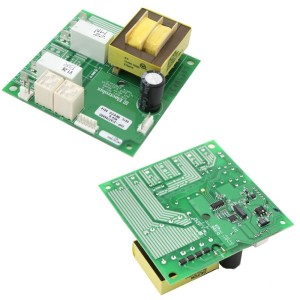
This range DIY repair guide shows how to replace a relay control board in a range. Some ranges have a relay control board instead of an oven control board. The relay control board responds to signals from the microprocessor display control board in the control panel by closing and opening relays to control voltage going to the burners/elements on the cooktop or in the oven. If the burners or elements don't work because a relay on the panel has failed, replace the relay control board with a manufacturer-approved range part.
This procedure shows how to replace the relay control board in Kenmore, Frigidaire, Electrolux, Whirlpool, KitchenAid, Maytag, Amana, GE, LG and Samsung ranges.
Instructions
- 01.
Shut off the power and gas
Carefully pull the range forward and unplug it. If necessary, have someone assist you when moving the range. Shut off the gas supply for a gas range or dual-fuel range.
Tip: Set the range on cardboard to prevent scratching the flooring. - 02.
Remove the lower back panel
Remove the screws that secure the back panel to the range—as you remove the last couple of screws, press the panel against the range so it doesn't fall.
Carefully lower the panel to the floor and then set it aside.
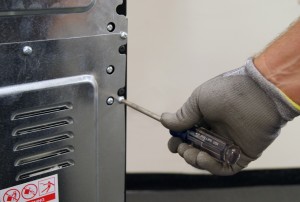
PHOTO: Remove the back panel screws.
- 03.
Disconnect the relay control board
Take a digital picture of the wires attached to the relay control board or mark them with numbered pieces of masking tape before removing them so you can attach the wires to the new control board correctly.
Disconnect all the wires from the relay control board.
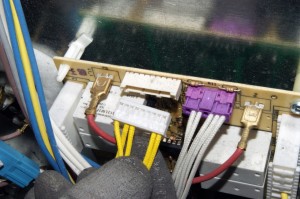
PHOTO: Disconnect the relay control board wires.
- 04.
Remove the relay control board
Remove the mounting screws that secure the relay control board to the back wall of the oven. Release the mounting clips that hold the relay control board in place. Remove the board and discard it safely.
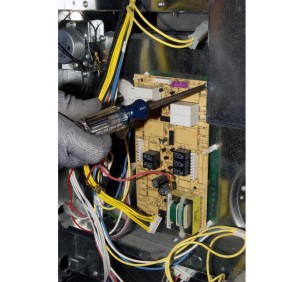
PHOTO: Remove the relay control board mounting screws.
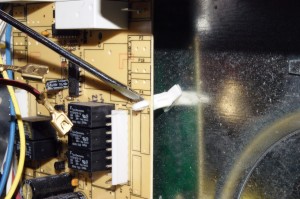
PHOTO: Release the relay control board mounting clips.

PHOTO: Remove the relay control board.
- 05.
Install the new relay control board
Ground yourself against the metal frame of the range to prevent static discharge damage to the control board before removing the new relay control board from the package. Carefully position it on the mounting clips and push it inward to lock the mounting clips in place. Insert the mounting screws and tighten them just past hand tight.
Warning: Before touching the new relay control board, wear a grounding strap or ground yourself by touching the metal frame of the range to discharge static electricity that could damage the control board. - 06.
Reconnect the wires
Carefully connect all the wires in the right location on the new relay control board, following your digital image or numbered tags.
Warning: it's crucial that all wires be connected properly to the new relay control board to prevent damage to range components and serious injury. If you're not sure how to properly connect the wires, we recommend having a service technician connect the wires and complete this repair. - 07.
Reattach the back panel
Position the upper back panel on the back of the range so that the mounting holes line up. Insert the mounting screws and tighten them to secure the back panel to the range.
- 08.
Turn on the gas and power
Turn on the gas supply. Plug in the range and push it into position. Ensure that the rear leveling foot is properly engaged in the anti-tip bracket.
Most common symptoms to help you fix your ranges
Choose a symptom to see related range repairs.
Main causes: broken oven door lock assembly, wiring failure, electronic control board problem…
Main causes: faulty temperature sensor, electronic control board problem, control thermostat failure, weak burner ignite…
Main causes: power supply problem, control thermostat or electronic control board failure, broken element, bad burner ig…
Main causes: food splatters, spilling food on the oven door, allowing liquid to drip through oven door vent when cleanin…
Main causes: broken broiler element, weak or broken broil burner igniter, control system failure, faulty temperature sen…
Main causes: bad bake element, broken burner igniter, control system failure, blown thermal fuse, faulty temperature sen…
Main causes: power supply failure, blown thermal fuse, bad relay control board, damaged terminal block, wiring failure…
Most common repair guides to help fix your ranges
These step-by-step repair guides will help you safely fix what’s broken on your range.

How to replace a range oven door switch
The oven door switch detects whether the oven door is closed and helps control the oven light. Replace the switch if it …

How to replace a range oven door lock assembly
Oven door not locking? You can replace the lock assembly in less than 30 minutes. Here's how.…
Effective articles & videos to help repair your ranges
Use the advice and tips in these articles and videos to get the most out of your range.

Learn how to clean and maintain your stove to keep it in top shape.…
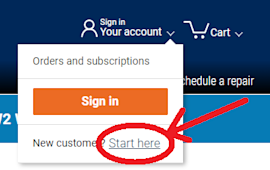
Learn about all the convenient features on our Sears PartsDirect website that make your parts purchases easier.…
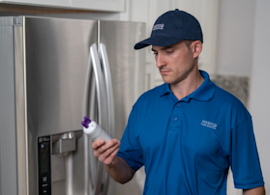
Get answers to frequently asked questions about Sears and Sears PartsDirect.…
